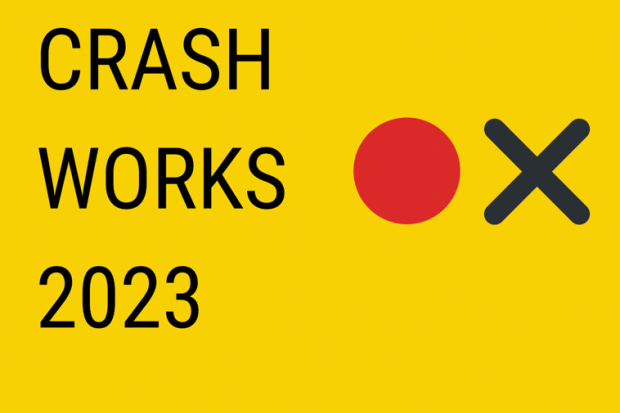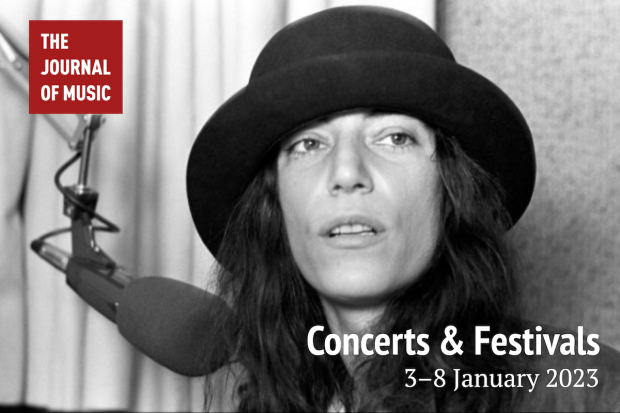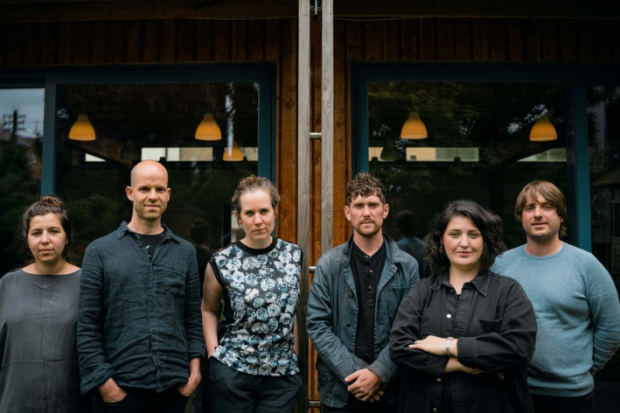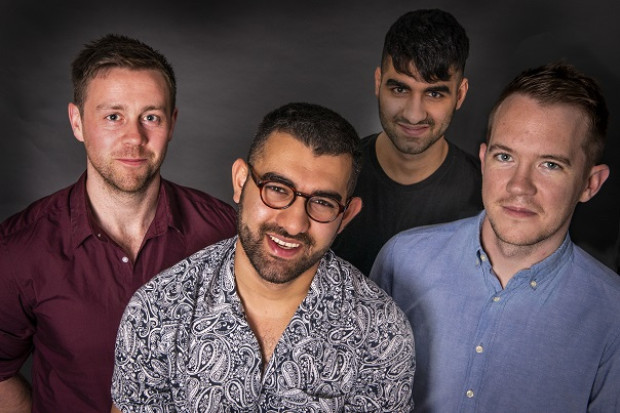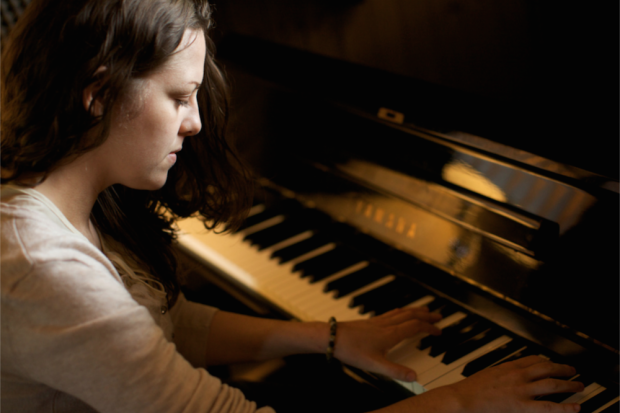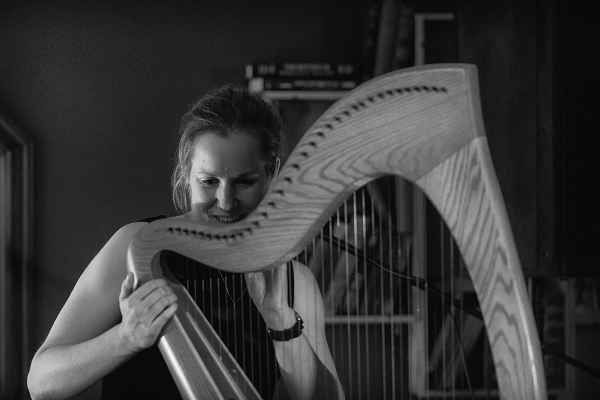
Úna Monaghan performing at Galway Jazz Festival last week (Photo: John Cronin, Dublin Jazz Photography).
Navigating Life and Art
The 2019 Galway Jazz Festival held a series of lunch-time concerts in the Black Gate, curated by Galway’s own jazz master Matthew Berrill. On 4 October, the festival welcomed Belfast artist Úna Monaghan, an established harper, composer, sound engineer and scholar. In her work, Monaghan explores the links between Irish traditional music and new technologies. She was joined on stage by renowned Kerry singer Pauline Scanlon.
The concert began with a solo performance by Monaghan on harp and laptop. Playing over a pre-composed electronic sample, made up of a drone, chimes, bird-like sounds and percussive noises reminiscent of knuckles and dance shoes hitting and scraping a hard wooden surface, she performed a series of semi-improvised melodies, fragmented scales and arpeggios that established a dialogue with the acoustic ambient created by the electronic patch.
This was followed by a piece that challenged her to improvise by deconstructing what she called the rhythmic ’scaffolding’ of Irish music, in a performance that fragmented a traditional Irish jig. To achieve this, Monaghan used a motion sensor device with a built-in gyroscope that she wore inside a fingerless glove on her left hand. The device detected her movements and sent a signal to the computer, which was then processed through a patch using the software Max MSP. In this particular piece, the software randomised and sent back improvised music which forced the harper to venture outside the structure of traditional music. The soundscape generated used timbres reminiscent of the sound of whales and of the acoustic renderings of a deep space wave signal. Perhaps this is why this piece is called Naomhóg, after the Kerry boats, or perhaps its name is a metaphor for her own navigation in the sea of musical improvisation.
Live performances are always unique experiences that cannot be repeated. This piece, however, takes this notion further as Monaghan creates soundscapes using material that the computer randomly sends to her. Her improvisational skills were matched by her technique, demonstrated in particular by her impeccable execution of tremolos.
Soundbites from nature
A performance of an electro-acoustic piece written for an art installation followed. The Bodélé Project, a collaboration with Dublin artist Mark Clare, was intended to represent visually and acoustically environmental processes that take place at a global scale. The original soundscape for the installation featured soundbites from nature and also Morse code translations of texts describing large-scale environmental processes played through old radios; Monaghan performed a set of jigs over this soundscape. The piece has a particular social significance for our times as it’s characterised by a growing awareness of climate change and our role in it. Also, it is important in the context of this year’s Galway Jazz Festival, which showed great leadership in its commitment to sustainability by championing initiatives like reducing artists’ mileage and unnecessary waste.
In the fourth piece, ‘What Haven’t We Heard?’, Monaghan was joined by Pauline Scanlon for a piece that addressed issues of gender imbalance in traditional Irish music. It is an issue that has been tackled by the Fair Plé movement of which Monaghan and Scanlon are co-founders. The first part was a very effective sonic rendition of gender percentages in traditional music. Monaghan performed a tune against an electronically generated drone, in which the percentage of male and female performers at the tutor concert at a major traditional music festival in 2017 was represented by the notes of the melody. She then told us she would play the same melody again but without the notes that corresponded to the difference in percentage, thus conveying sonically a sense of void and the degree of gender misrepresentation. The second part was a musical adaptation of a text written by Belfast-based poet Maureen Boyle, sung by Scanlon. For the third and last part, Monaghan and Scanlon read a series of anonymous stories collected from women in Irish traditional music which told episodes of discrimination and which were interjected by fragments of popular Irish songs such as ‘Molly Malone’ or ‘Óró sé do bheatha bhaile’. This piece provided a unique platform for these voices to be heard and conveyed a sense of continuity between social reality and musical performance.
A robotic filter
The fifth and last work was a tribute to her partner’s grandmother and her friends. Monaghan was fascinated by the musicality of their conversation so she recorded it and sampled it. The women voices were played back with a robotic filter but they became clearer as the piece went on. With their words as an acoustic contextual frame, Monaghan harmonised the voices on harp and played a melody over them that followed the natural flow, speed and dynamics of the conversation.
‘Weaving’ is a term often used as an analogy for music, especially when talking about melodies and harmony. Throughout this concert it felt that this analogy was never more appropriate. Visually, the harp reminded me of an upright loom. Musically, Monaghan masterfully managed to not only intertwine the apparently distant worlds of Irish traditional music and electronic composition, but also illustrate the intersection between social narratives (the ’real‘ world) and the arts in a seamless way.
For more on Una Monaghan, visit www.unamonaghan.com.
–
This is the eighth review published as part of the Journal of Music/Galway City and County Music Writer Mentoring Scheme 2019 which is supported by Galway City Council and Galway County Council Arts Offices. Over the course of a year the editorial team of the Journal of Music work with six new writers – Rachel Deckard, Massimo Cattaneo, Jake Tiernan and Kerri Haberlin (Galway City), and James Fleming and Tara Broderick (County Galway) – and publish their reviews of music in Galway.
Published on 10 October 2019
Massimo Cattaneo is currently completing his PhD in Spanish and Ethnomusicology in NUI Galway (co-supervised by the University of Limerick). He is a recipient of the NUI Galway Doctoral Fellowship. Massimo’s research focusses on the introduction of flute in flamenco and its effects on identity and on notions of purity and authenticity. A former participant of the Access Music Project, Galway, he has qualifications in music theory, piano and vocals. From 2010 to 2014, Massimo wrote, presented and produced The Spinning World, a world music radio programme for Flirt FM. He has also worked in music production with Improvised Music Company. Massimo plays Irish traditional flute, flamenco guitar and bass. Massimo was a participant in the Journal of Music/Galway City Council Music Writer Mentoring Scheme.












